Abstract
A strain of Pseudomonas cepacia that survived for 14 years (1963 to 1977) as a contaminant in an inorganic salt solution which contained commercial 0.05% benzalkonium chloride (CBC) as an antimicrobial preservative, was compared to a recent clinical isolate of P. cepacia. Ammonium acetate was present in the concentrated stock CBC solution, and served as a carbon and nitrogen source for growth when carried over into the salts solution with the CBC. The isolate's resistance to pure benzalkonium chloride was increased step-wise to a concentration of 16%. Plate counts showed 4 x 10(3) colony-forming units per ml in the salts solution. Comparison of growth rates, mouse virulence, antibiotics resistance spectra, and substrate requirements disclosed no differences between the contaminant and a recently isolated clinical strain of P. cepacia. The results indicate that it is critical that pharmaceutical solutions containing benzalkonium chloride as an antimicrobial preservative be formulated without extraneous carbon and nitrogen sources or be preserved with additional antimicrobial agents.
Full text
PDF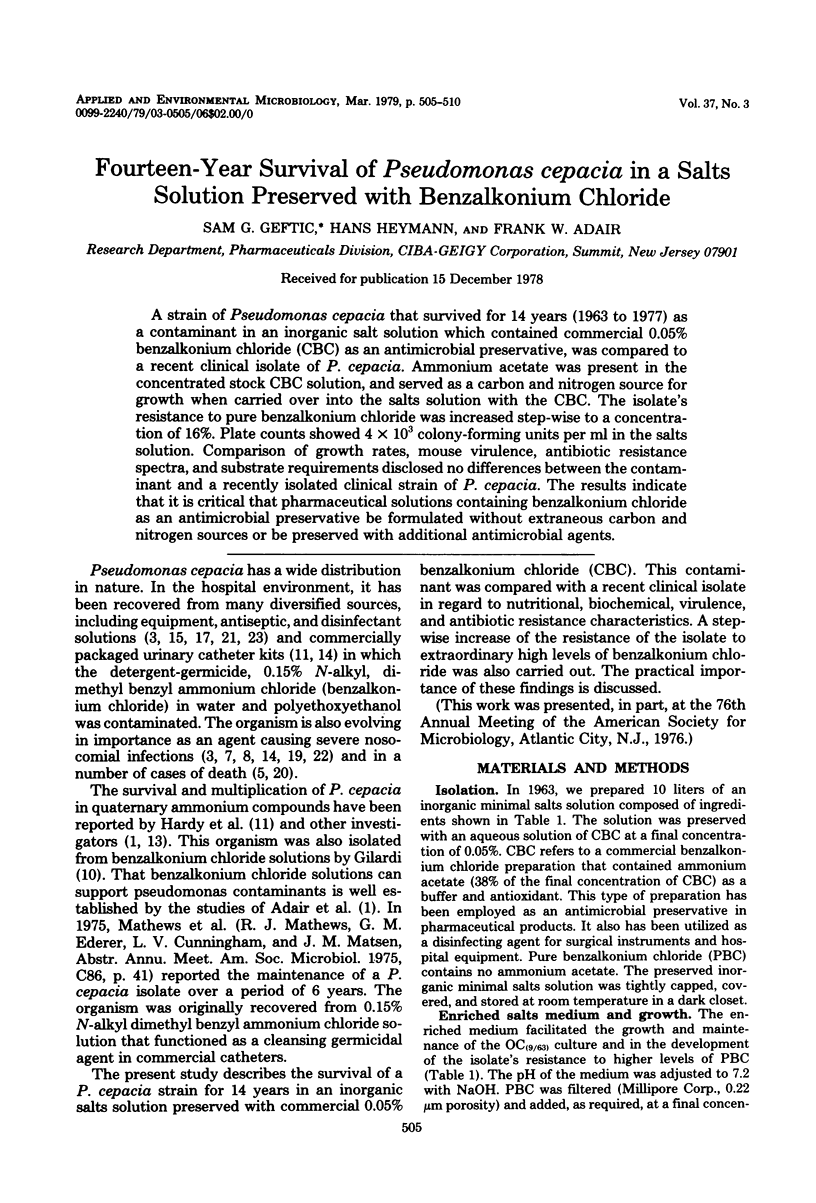
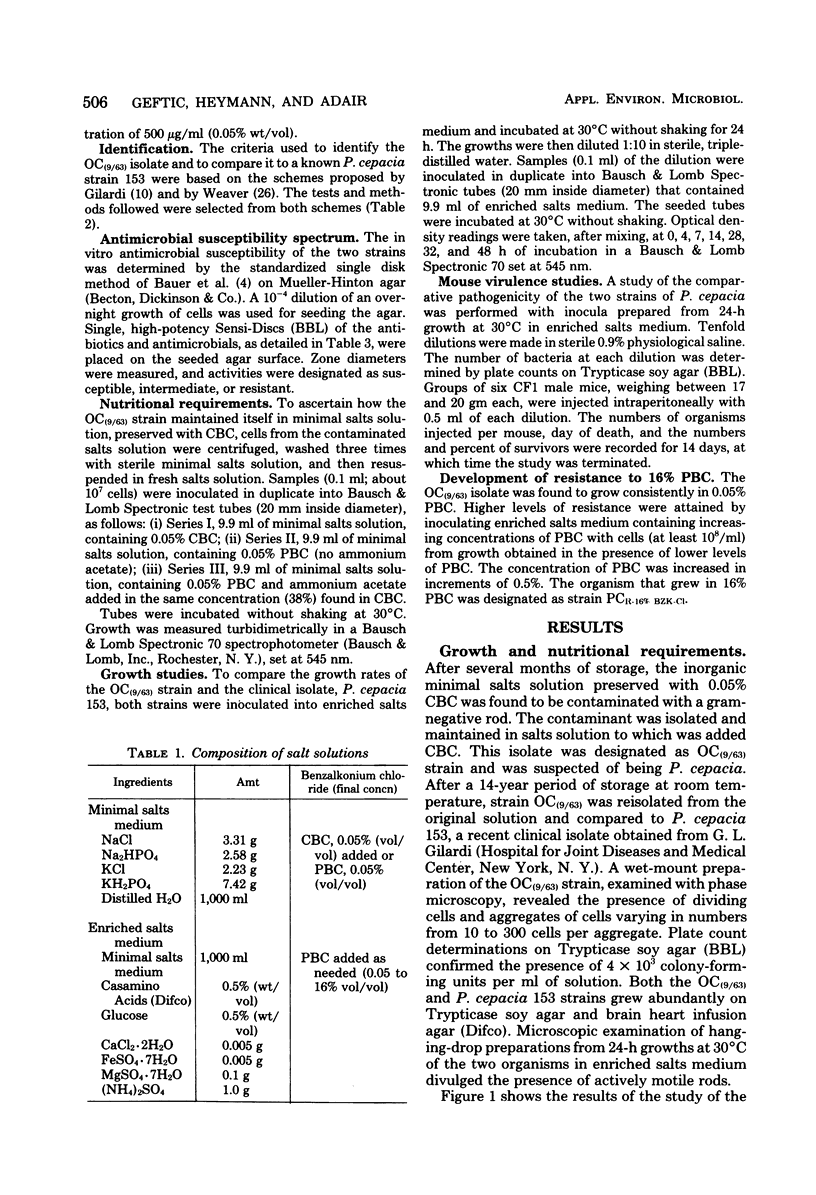
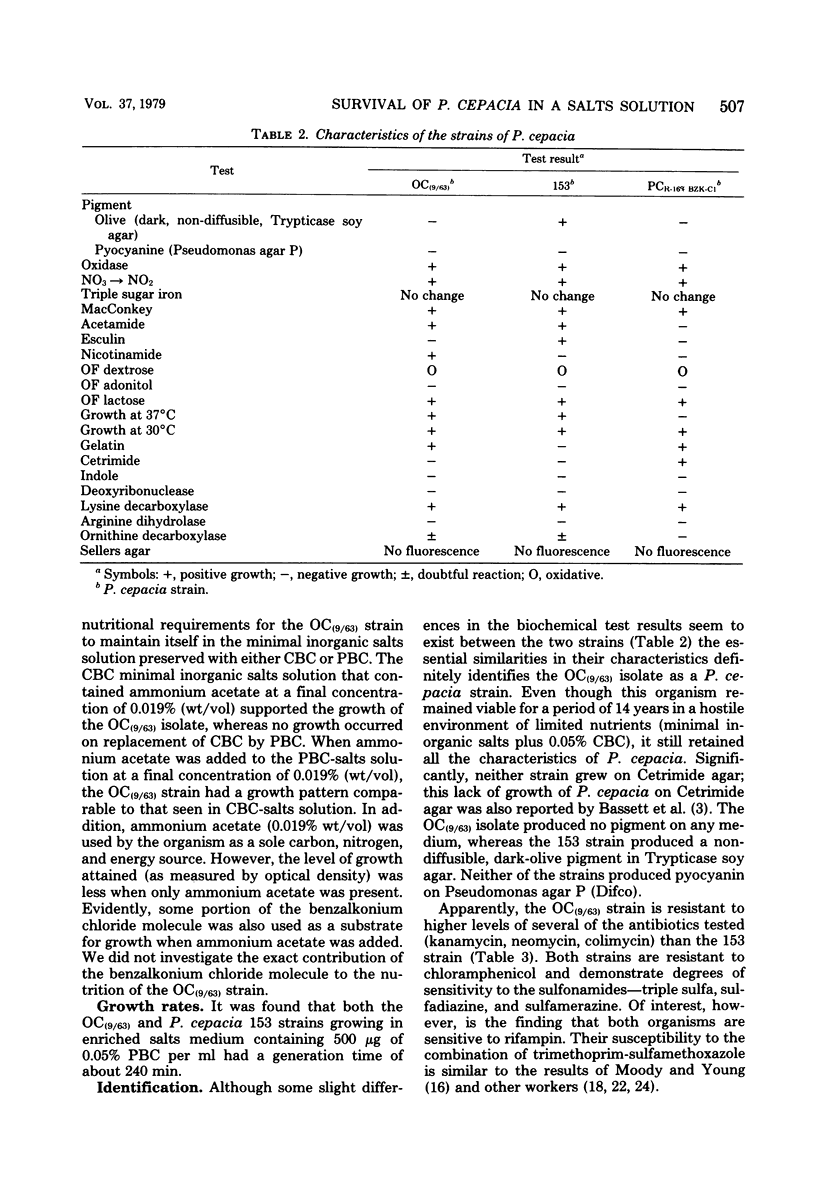
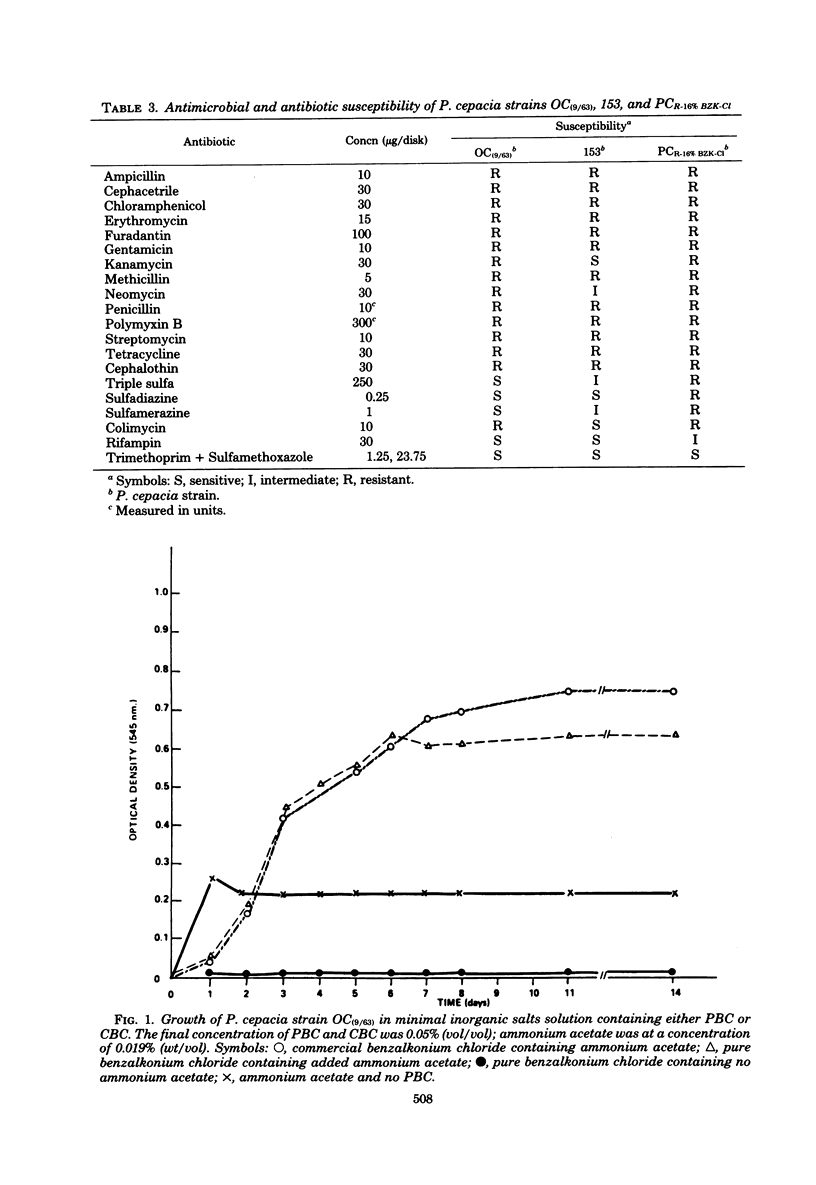
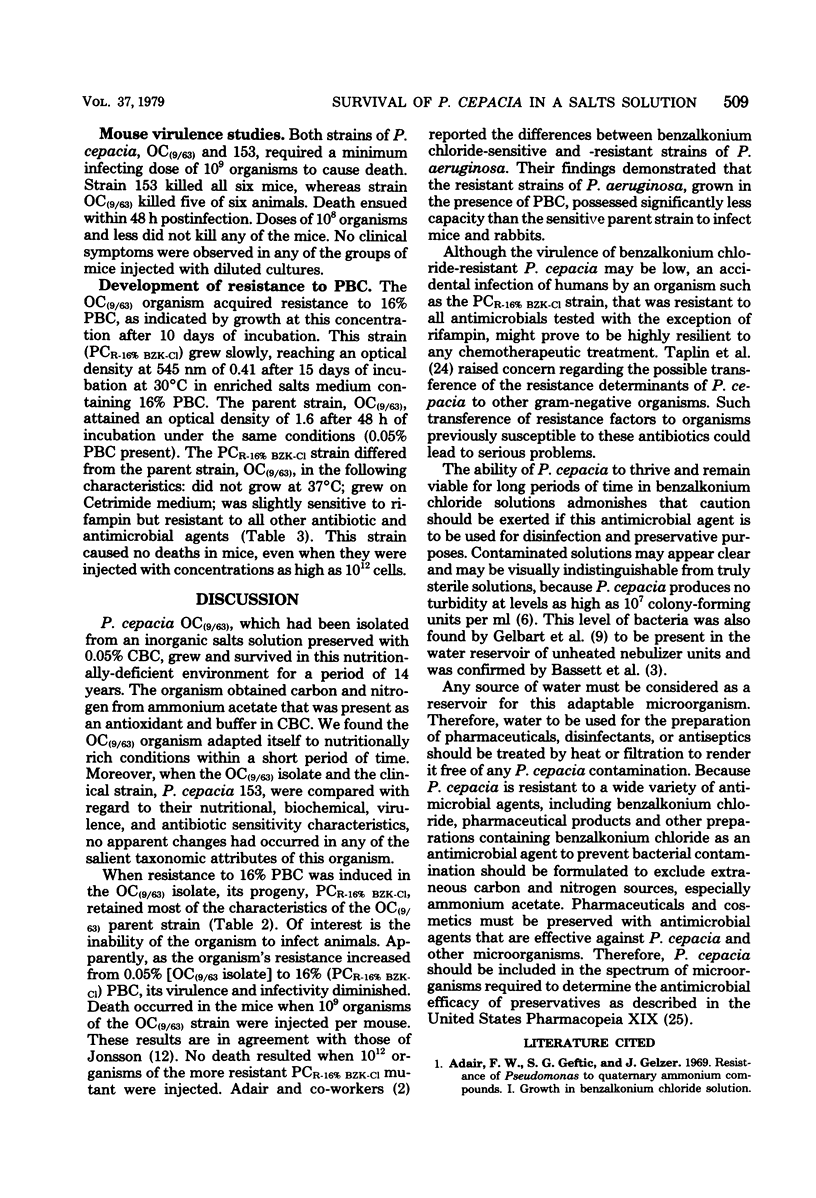
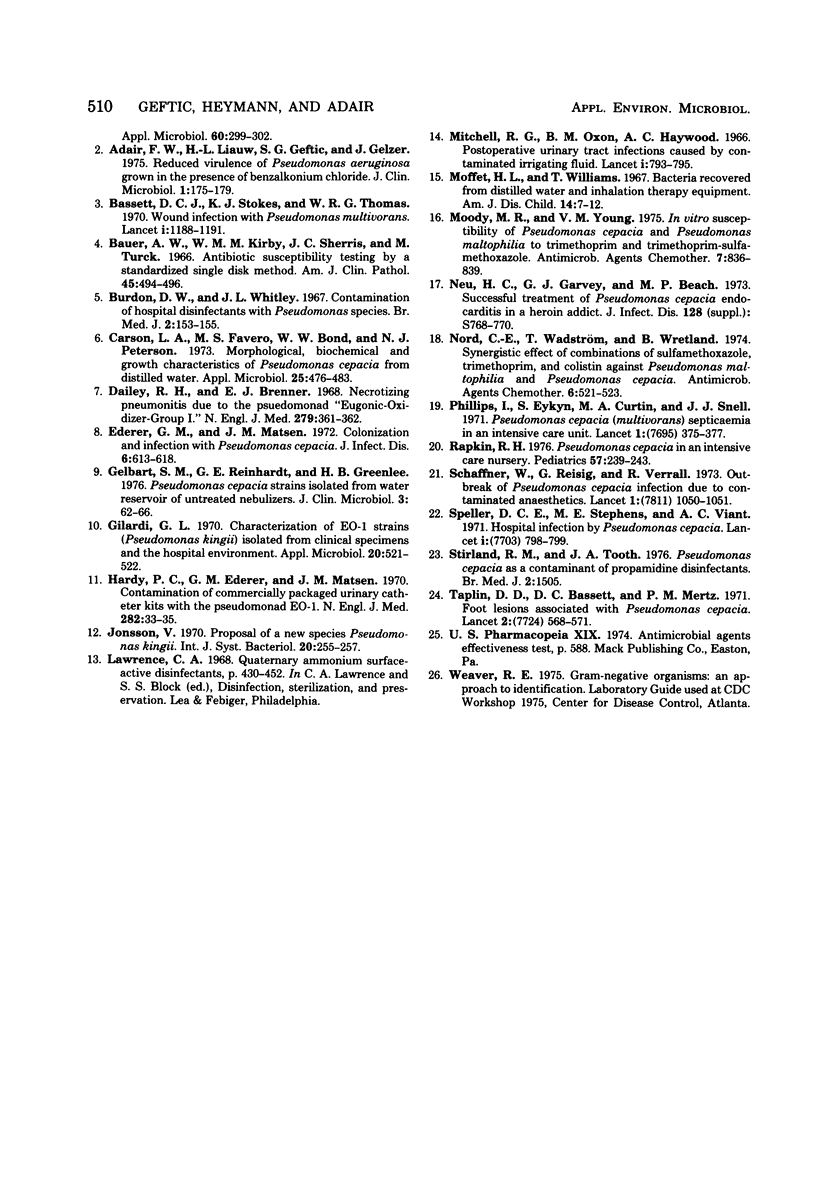
Selected References
These references are in PubMed. This may not be the complete list of references from this article.
- Adair F. W., Liauw H. L., Geftic S. G., Gelzer J. Reduced virulence of Pseudomonas aeruginosa grown in the presence of benzalkonium chloride. J Clin Microbiol. 1975 Feb;1(2):175–179. doi: 10.1128/jcm.1.2.175-179.1975. [DOI] [PMC free article] [PubMed] [Google Scholar]
- Bassett D. C., Stokes K. J., Thomas W. R. Wound infection with Pseudomonas multivorans. A water-borne contaminant of disinfectant solutions. Lancet. 1970 Jun 6;1(7658):1188–1191. doi: 10.1016/s0140-6736(70)91783-6. [DOI] [PubMed] [Google Scholar]
- Bauer A. W., Kirby W. M., Sherris J. C., Turck M. Antibiotic susceptibility testing by a standardized single disk method. Am J Clin Pathol. 1966 Apr;45(4):493–496. [PubMed] [Google Scholar]
- Burdon D. W., Whitby J. L. Contamination of hospital disinfectants with Pseudomonas species. Br Med J. 1967 Apr 15;2(5545):153–155. doi: 10.1136/bmj.2.5545.153. [DOI] [PMC free article] [PubMed] [Google Scholar]
- Carson L. A., Favero M. S., Bond W. W., Petersen N. J. Morphological, biochemical, and growth characteristics of pseudomonas cepacia from distilled water. Appl Microbiol. 1973 Mar;25(3):476–483. doi: 10.1128/am.25.3.476-483.1973. [DOI] [PMC free article] [PubMed] [Google Scholar]
- Dailey R. H., Benner E. J. Necrotizing pneumonicitis due to the pseudomonad "eugonic oxidizer--group I". N Engl J Med. 1968 Aug 15;279(7):361–362. doi: 10.1056/NEJM196808152790706. [DOI] [PubMed] [Google Scholar]
- Ederer G. M., Matsen J. M. Colonization and infection with Pseudomonas cepacia. J Infect Dis. 1972 Jun;125(6):613–618. doi: 10.1093/infdis/125.6.613. [DOI] [PubMed] [Google Scholar]
- Gelbart S. M., Reinhardt G. F., Greenlee H. B. Pseudomonas cepacia strains isolated from water reservoirs of unheated nebulizers. J Clin Microbiol. 1976 Jan;3(1):62–66. doi: 10.1128/jcm.3.1.62-66.1976. [DOI] [PMC free article] [PubMed] [Google Scholar]
- Gilardi G. L. Characterization of EO-1 strains (Pseudomonas kingii) isolated from clinical specimens and the hospital environment. Appl Microbiol. 1970 Sep;20(3):521–522. doi: 10.1128/am.20.3.521-522.1970. [DOI] [PMC free article] [PubMed] [Google Scholar]
- Hardy P. C., Ederer G. M., Matsen J. M. Contamination of commercially packaged urinary catheter kits with the pseudomonad EO-1. N Engl J Med. 1970 Jan 1;282(1):33–35. doi: 10.1056/NEJM197001012820108. [DOI] [PubMed] [Google Scholar]
- Mitchell R. G., Hayward A. C. Postoperative urinary-tract infections caused by contaminated irrigating fluid. Lancet. 1966 Apr 9;1(7441):793–795. doi: 10.1016/s0140-6736(66)91866-6. [DOI] [PubMed] [Google Scholar]
- Moffet H. L., Williams T. Bacteria recovered from distilled water and inhalation therapy equipment. Am J Dis Child. 1967 Jul;114(1):7–12. doi: 10.1001/archpedi.1967.02090220013002. [DOI] [PubMed] [Google Scholar]
- Moody M. R., Young W. M. In vitro susceptibility of Pseudomanas cepacia and Pseudomonas maltophilia to trimethoprim and trimethoprim-sulfamethoxazole. Antimicrob Agents Chemother. 1975 Jun;7(6):836–839. doi: 10.1128/aac.7.6.836. [DOI] [PMC free article] [PubMed] [Google Scholar]
- Nord C. E., Wadström T., Wretlind B. Synergistic effect of combinations of sulfamethoxazole, trimethoprim, and colistin against Pseudomonas maltophilia and Pseudomonas cepacia. Antimicrob Agents Chemother. 1974 Oct;6(4):521–523. doi: 10.1128/aac.6.4.521. [DOI] [PMC free article] [PubMed] [Google Scholar]
- Phillips I., Eykyn S., Curtis M. A., Snell J. J. Pseudomonas cepacia (multivorans) septicaemia in an intensive-care unit. Lancet. 1971 Feb 20;1(7695):375–377. doi: 10.1016/s0140-6736(71)92212-4. [DOI] [PubMed] [Google Scholar]
- Pseudomonas cepacia as contaminant of propamidine disinfectants. Br Med J. 1976 Dec 18;2(6050):1505–1505. doi: 10.1136/bmj.2.6050.1505-a. [DOI] [PMC free article] [PubMed] [Google Scholar]
- Rapkin R. H. Pseudomonas cepacia in an intensive care nursery. Pediatrics. 1976 Feb;57(2):239–243. [PubMed] [Google Scholar]
- Schaffner W., Reisig G., Verrall R. A. Outbreak of Pseudomonas cepacia infection due to contaminated anaesthetics. Lancet. 1973 May 12;1(7811):1050–1051. doi: 10.1016/s0140-6736(73)90680-6. [DOI] [PubMed] [Google Scholar]
- Speller D. C., Stephens M. E., Viant A. C. Hospital infection by Pseudomonas cepacia. Lancet. 1971 Apr 17;1(7703):798–799. doi: 10.1016/s0140-6736(71)91236-0. [DOI] [PubMed] [Google Scholar]
- Taplin D., Bassett D. C., Mertz P. M. Foot lesions associated with Pseudomonas cepacia. Lancet. 1971 Sep 11;2(7724):568–571. doi: 10.1016/s0140-6736(71)92150-7. [DOI] [PubMed] [Google Scholar]


